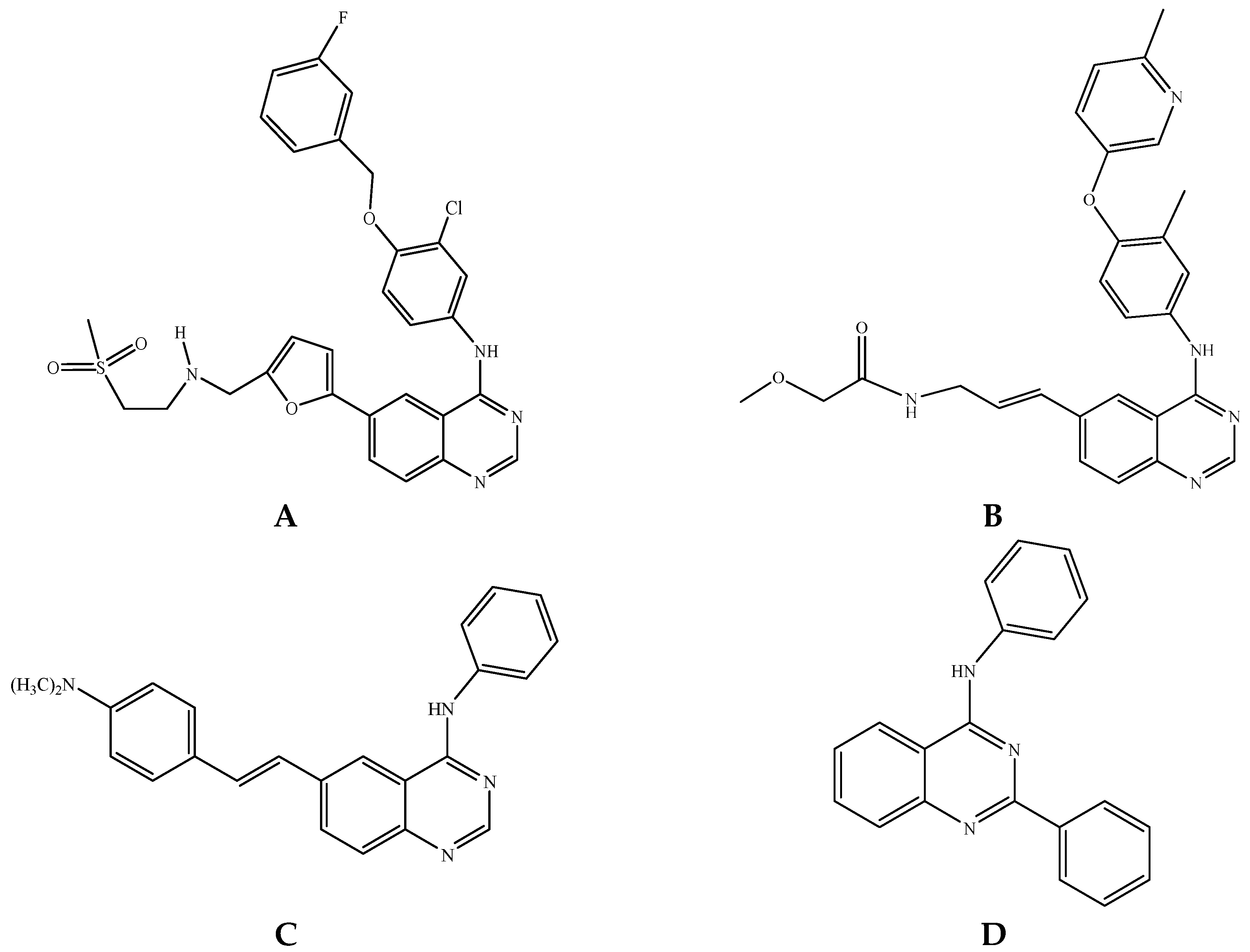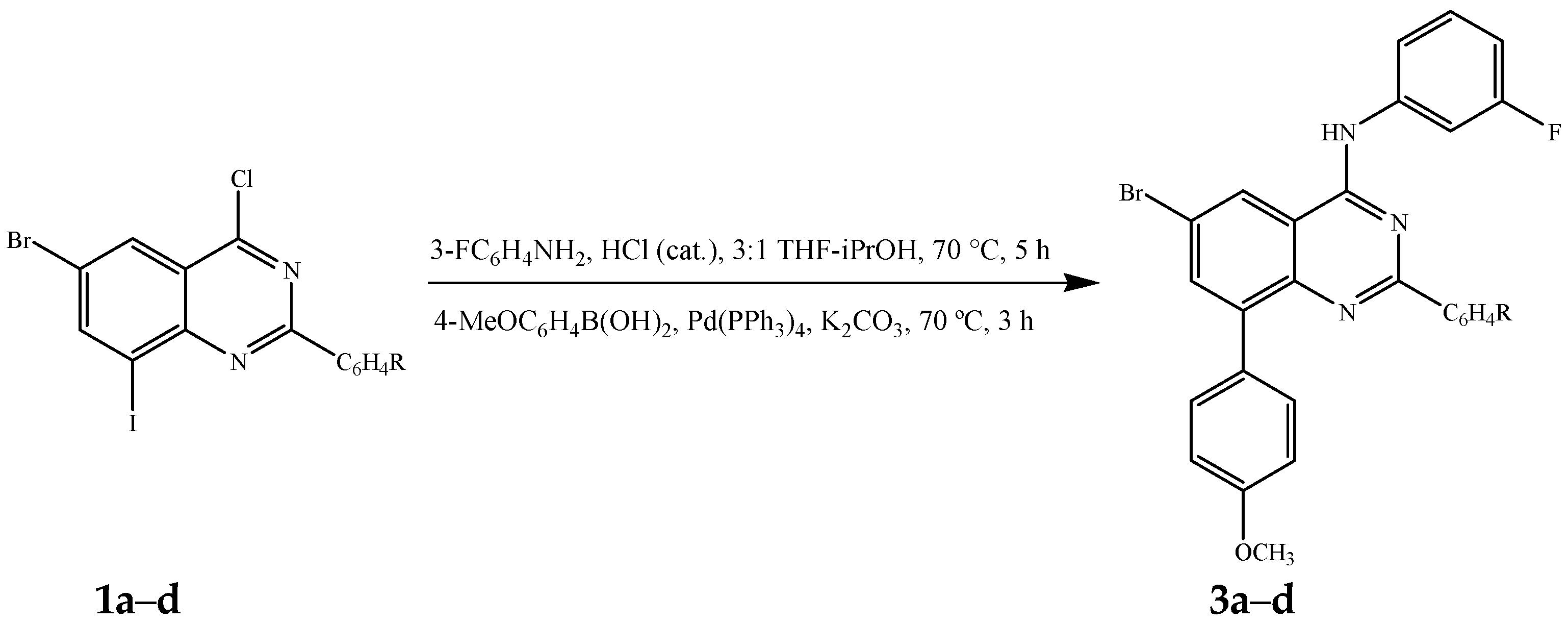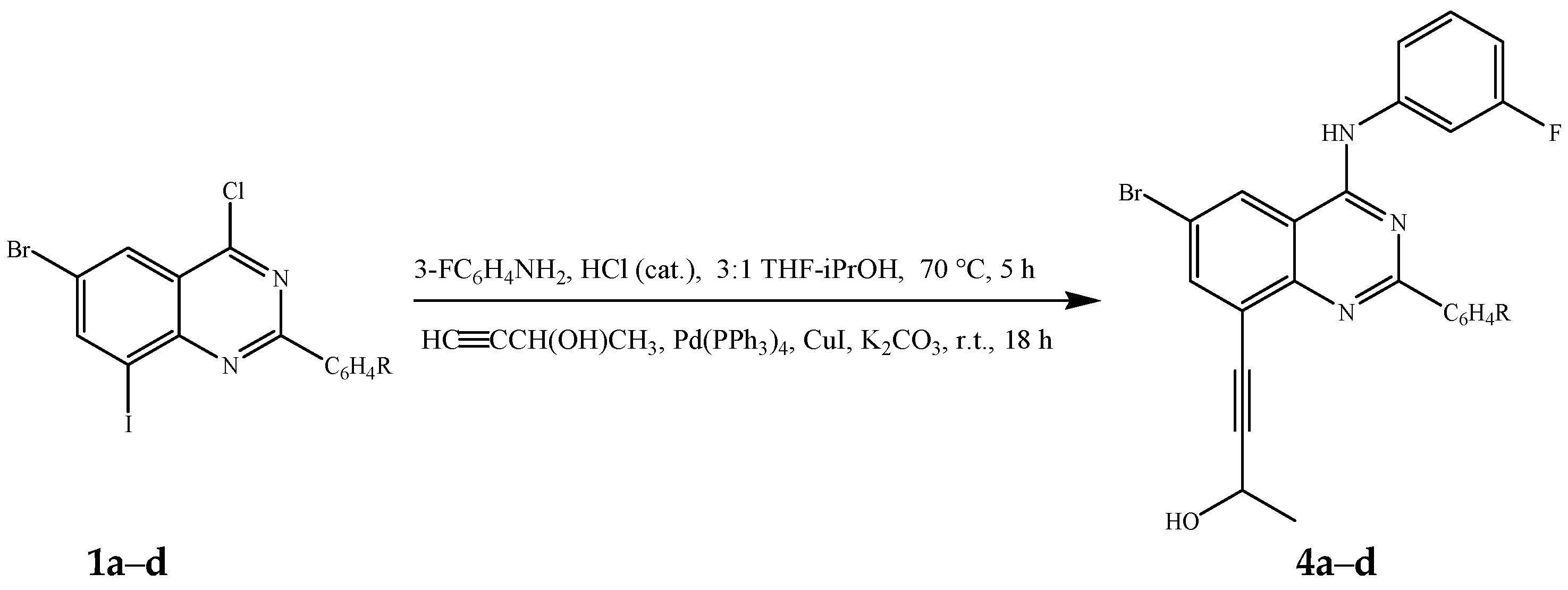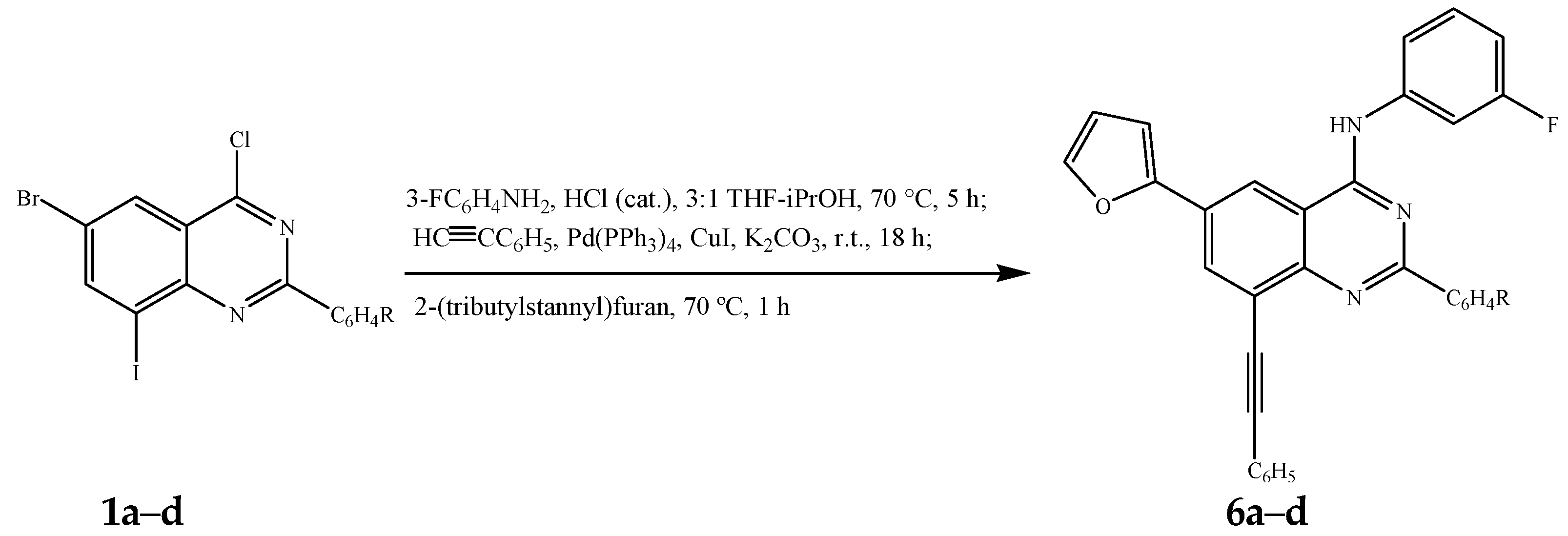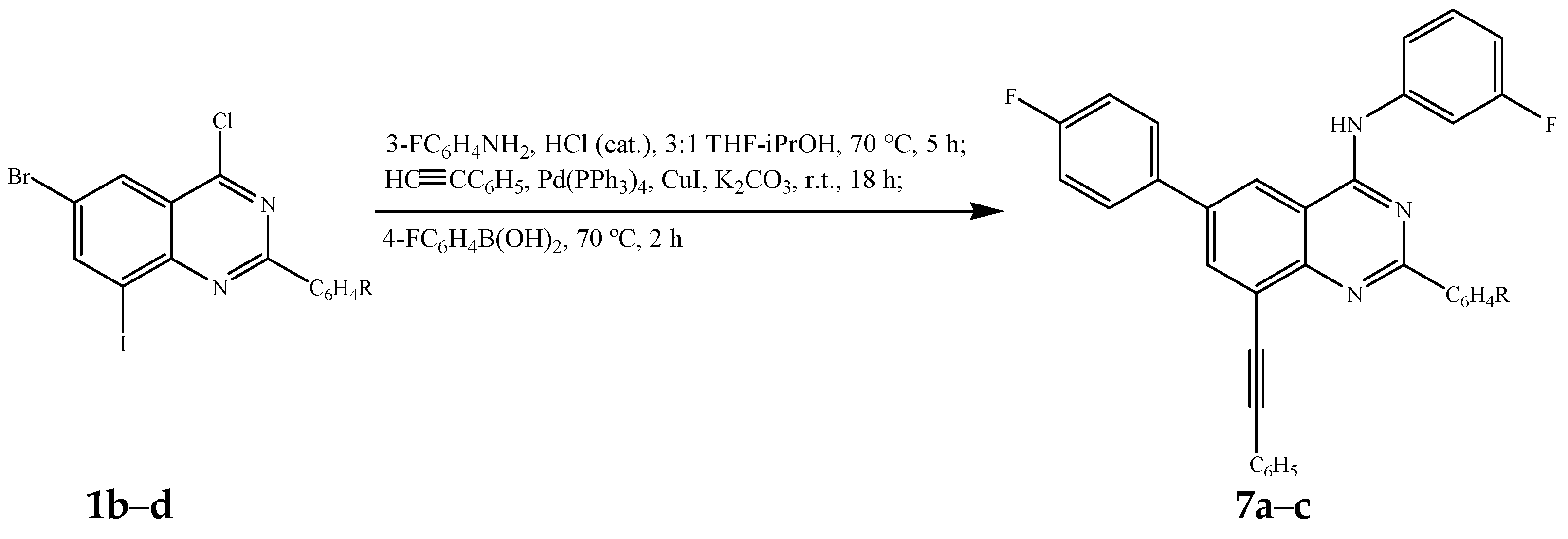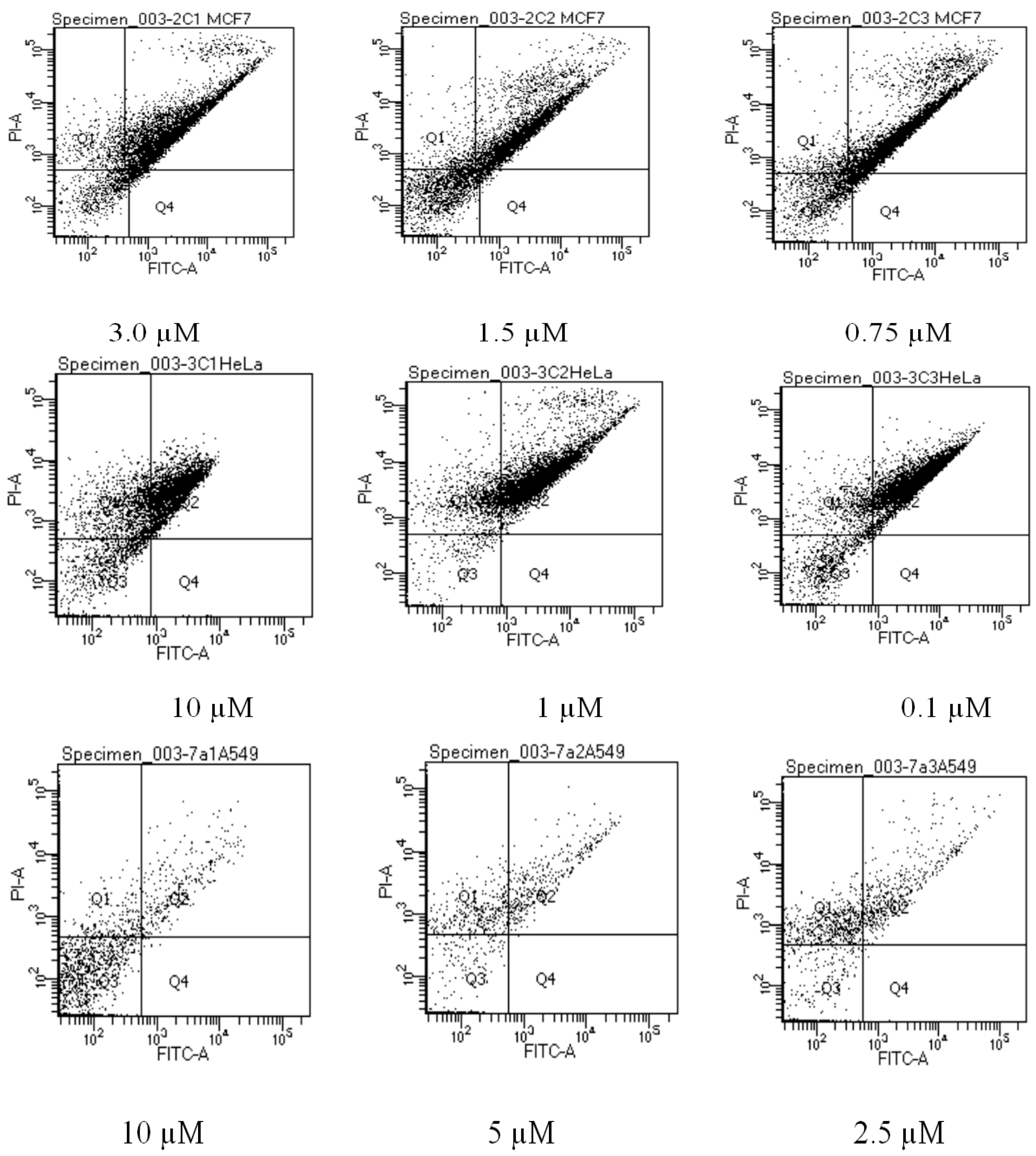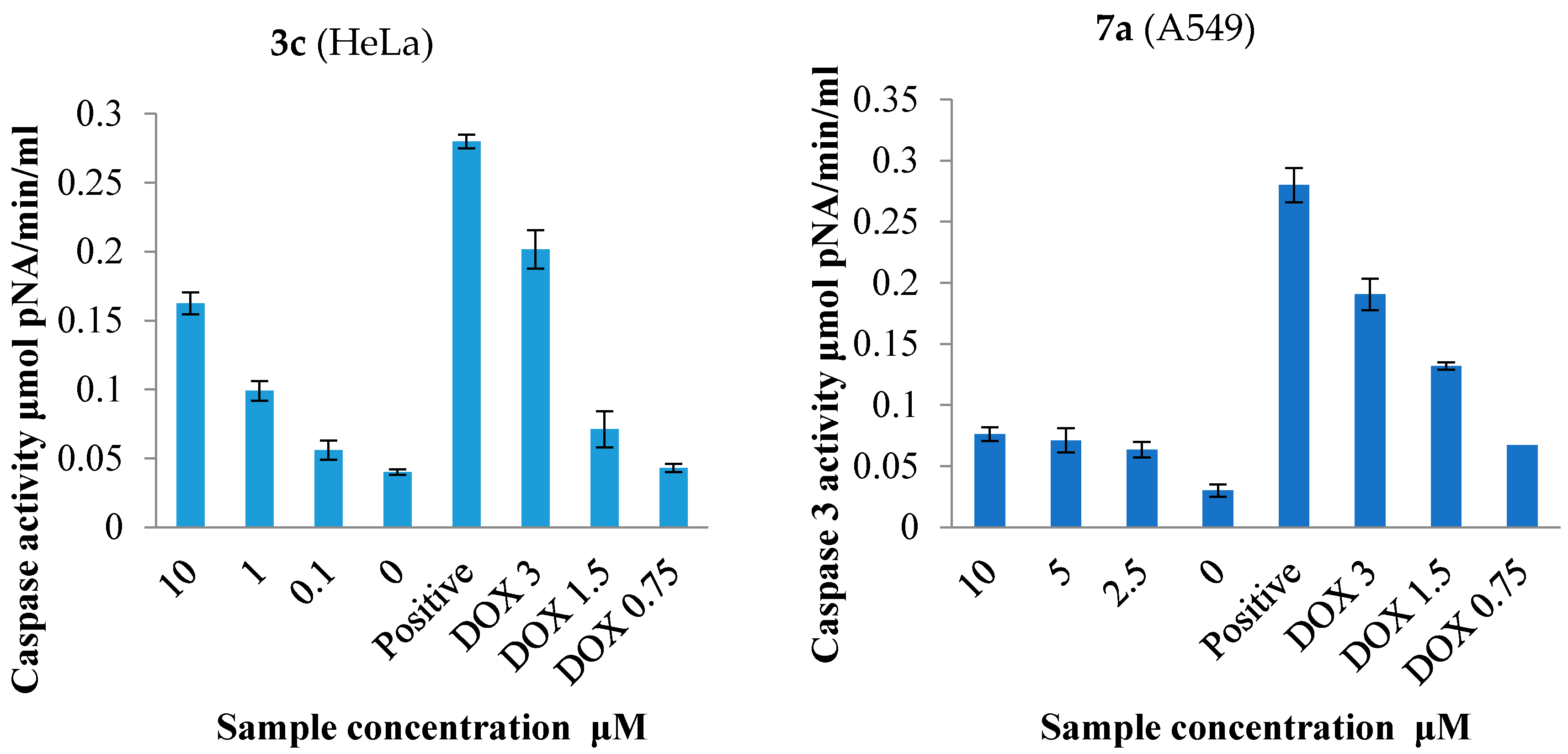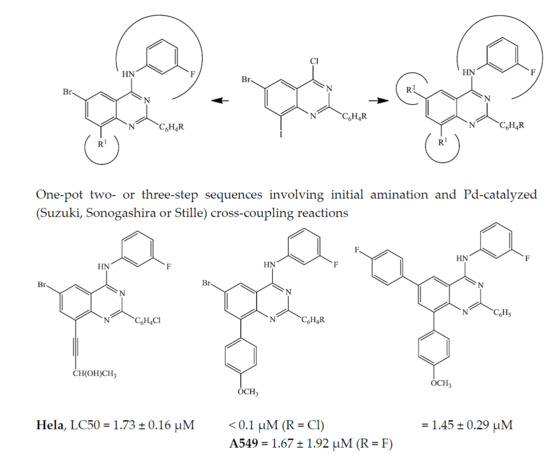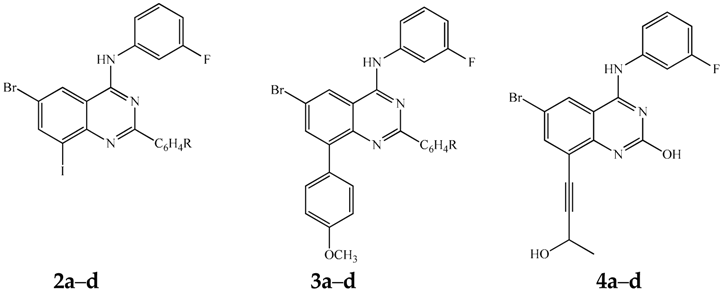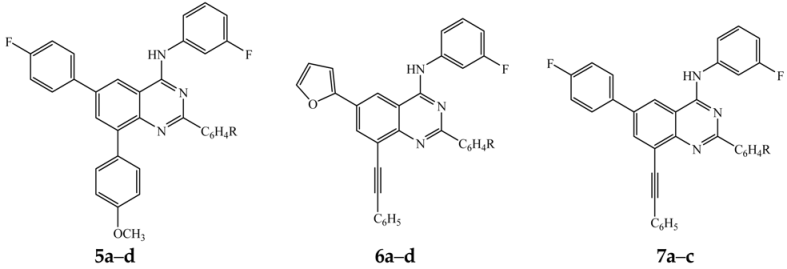3. Experiments
3.1. General
Melting points were recorded on a Thermocouple digital melting point apparatus (Stuart, Staffordshire, UK) and are uncorrected. IR spectra were recorded as powders using a Bruker VERTEX 70 FT-IR Spectrometer (Bruker Optics, Billerica, MA, USA) with a diamond ATR (attenuated total reflectance) accessory by using the thin-film method. For column chromatography, Merck kieselgel 60 (0.063–0.200 mm) (Merck KGaA, Frankfurt, Germany) was used as stationary phase. NMR spectra were obtained as CDCl
3 solutions using Agilent 500 MHz NMR (Agilent Technologies, Oxford, UK) spectrometer and the chemical shifts are quoted relative to the TMS peak. Low- and high-resolution mass spectra were recorded using Waters Synapt G2 Quadrupole Time-of-flight mass spectrometer (Waters Corp., Milford, MA, USA) at the University of Stellenbosch Mass Spectrometry Unit. The synthesis and characterization of compounds
1a–
d have been described before [
20].
3.2. Typical Procedure for the Dechloro-Aminination of 1a–d
A stirred mixture of 1 (1 equivalent), 3-fluoroaniline (1.1 equivalent) and concentrated HCl (0.01 g, 0.27 mmol) in 3:1 THF-isopropanol (5 mL/mmol of 1) was heated at 70 °C for 5 h and then allowed to cool to RT The reaction mixture was quenched with an ice-cold water and the product was extracted into ethyl acetate. The organic layers were washed with an aqueous solution of NaHCO3, dried over anhydrous MgSO4, filtered and evaporated under reduced pressure to afford 2 as a solid. The following products (2a–d) were prepared in this fashion:
6-Bromo-N-(3-fluorophenyl)-8-iodo-2-phenylquinazolin-4-amine (2a). Yellow solid (1.07 g, 92%), mp. 199–200 °C; νmax (ATR) 445, 551, 701, 770, 957, 1128, 1306, 1397, 1448, 1541, 1590, 1616, 3424 cm−1; δH (500 MHz, DMSO-d6) 7.02 (td, J = 2.5 and 8.0 Hz, 1H), 7.50 (q, J = 8.0 Hz, 1H), 7.55–7.58 (m, 3H), 7.75 (d, J = 8.5 Hz, 1H), 7.95 (dt, J = 2.0 and 11.5 Hz, 1H), 8.48–8.49 (m, 2H), 8.57 (d, J = 1.5 Hz, 1H), 8.89 (d, J = 1.5 Hz, 1H), 10.13 (s, 1H); δC (125 MHz, DMSO-d6) 105.2, 109.3 (d, 2JCF = 26.5 Hz), 110.8 (d, 2JCF = 20.9 Hz), 115.7, 118.2 (d, 4JCF = 2.8 Hz), 119.4, 126.3, 128.5, 129.1, 130.6 (d, 3JCF = 8.5 Hz), 131.5, 137.9, 141.2 (d, 3JCF = 11.3 Hz), 145.2, 149.2, 157.9, 160.5, 162.4 (d, 1JCF = 239.8 Hz); m/z 520 (100, MH+); HRMS (ES): MH+, found 519.9230. C20H13BrFIN3+ requires 519.9243.
3.3. Typical Procedure for the One-Pot Two-Step Sequential Amination and Suzuki–Miyaura Cross-Coupling of 1a–d
6-Bromo-N-(3-fluorophenyl)-8-(4-methoxyphenyl)-2-phenylquinazolin-4-amine (3a). A stirred mixture of 1a (0.50 g, 1.12 mmol), 3-fluoroaniline (0.14 g, 1.23 mmol) and concentrated HCl (0.01 g, 0.27 mmol) in 3:1 THF-isopropanol (v/v, 10 mL) was heated at 70 °C for 5 h until the starting material was completely consumed (thin layer chromatography monitoring) and then cooled to RT. The cooled mixture was treated sequentially with Pd(PPh3)4 (0.064 g, 0.056 mmol) and a solution of K2CO3 (0.46 g, 3.36 mmol) in water (5 mL) followed by purging with argon gas for 30 min. A solution of 4-methoxyphenylboronic acid (0.20 g, 1.34 mmol) in THF (5 mL) was then injected using a syringe. The reaction mixture was stirred at 70 °C for additional 3 h and then quenched with an ice-cold water. The product was extracted with ethyl acetate and the combined organic layers were washed with water, dried over Mg2SO4, filtered and evaporated under reduced pressure. The residue was purified by column chromatography on silica gel to afford 3a as a yellow solid (0.45 g, 82%), Rf (toluene) 0.40, mp. 210–211 °C; νmax (ATR) 450, 501, 565, 676, 717, 773, 829, 975, 1061, 1147, 1289, 1351, 1395, 1440, 1557, 1607, 2846, 3018, 3426 cm−1; δH (500 MHz, DMSO-d6) 3.86 (s, 3H), 7.00 (td, J = 2.0 and 8.5 Hz, 1H), 7.10 (d, J = 8.5 Hz, 2H), 7.50 (m, 4H), 7.77 (d, J = 8.5 Hz, 2H), 7.79 (d, J = 8.5 Hz, 1H), 7.97 (d, J = 2.5 Hz, 1H), 8.00 (dt, J = 2.0 and 8.5 Hz, 1H), 8.30–8.32 (m, 2H), 8.82 (d, J = 2.0 Hz, 1H), 10.04 (s, 1H); δC (125 MHz, DMSO-d6) 55.6, 109.1 (d, 2JCF = 26.6 Hz), 110.3 (d, 2JCF = 20.8 Hz), 113.7, 116.2, 118.0 (d, 4JCF = 2.7 Hz), 119.0, 124.5, 128.3, 129.0, 129.3, 129.7, 130.5 (d, 3JCF = 9.5 Hz), 131.0, 132.5, 135.9, 138.5, 141.3 (d, 3JCF = 10.3 Hz), 147.3, 157.7, 158.9, 159.5, 162.5 (d, 1JCF = 239.0 Hz); m/z 500 (100, MH+); HRMS (ES): MH+, found 500.0780. C27H20BrFN3O+ requires 500.0774.
3.4. Typical Procedure for the One-Pot Two-Step Sequential Amination and Sonogashira Cross-Coupling of 1a–d
4-[6-Bromo-4-(3-fluorophenylamino)-2-phenylquinazolin-8-yl]but-3-yn-2-ol (4a). A stirred mixture of 1a (0.40 g, 0.89 mmol), 3-fluoroaniline (0.11 g, 0.98 mmol) and concentrated HCl (0.01 g, 0.27 mmol) in 3:1 THF-isopropanol (v/v, 10 mL) in a two necked flask equipped with rubber septum and a condenser fitted with calcium chloride tube was heated at 70 °C for 5 h. After cooling, Pd(PPh3)4 (0.051 g, 0.044 mmol), CuI (0.008 g, 0.044 mmol) K2CO3 (0.37 g, 2.67 mmol) and 3-butyn-2-ol (0.081 g, 1.15 mmol) in THF (5 mL) were introduced to the mixture under argon atmosphere. A balloon filled with argon was fitted to the top of the condenser and the mixture was stirred for additional 18 h at RT under argon atmosphere. The mixture was quenched with an ice-cold water and the product was extracted with ethyl acetate. The combined organic layers were washed with water, dried over anhyd. MgSO4, filtered and evaporated under reduced pressure. The residue was purified by column chromatography on silica gel to afford 4a as an orange solid (0.26 g, 63%), Rf (9:1 toluene–ethyl acetate) 0.26, mp. 172–174 °C; νmax (ATR) 539, 697, 712, 782, 861, 1071, 1142, 1368, 1470, 1524, 1556, 1612, 2924, 3070, 3308, 3478 cm−1; δH (500 MHz, DMSO-d6) 1.51 (d, J = 6.5 Hz, 3H), 4.76 (d, J = 6.0 Hz, 1H), 5.60 (d, J = 6.0 Hz, 1H), 7.00 (td, J = 2.5 and 8.0 Hz, 1H), 7.51 (q, J = 8.0 Hz, 1H), 7.52–7.59 (m, 3H), 7.74 (d, J = 8.0 Hz, 1H), 7.95 (dt, J = 2.0 and 11.5 Hz, 1H), 8.05 (d, J = 2.0 Hz, 1H), 8.46–8.49 (m, 2H), 8.83 (d, J = 2.0 Hz, 1H), 10.06 (s, 1H); δC (125 MHz, DMSO-d6) 24.9, 57.1, 78.6, 101.2, 109.0 (d, 2JCF = 25.6 Hz), 110.5 (d, 2JCF = 20.8 Hz), 115.5, 117.8, 117.9 (d, 4JCF = 2.8 Hz), 119.1, 128.2, 128.3, 128.7, 130.3 (d, 3JCF = 9.5 Hz), 131.1, 137.8, 138.9, 140.9 (d, 3JCF = 11.3 Hz), 150.9, 157.3, 159.5, 162.2 (d, 1JCF = 239.0 Hz); m/z 462 (100, MH+); HRMS (ES): MH+, found 462.0620. C24H18BrFN3O+ requires 462.0617.
3.5. Typical Procedure for the One-Pot Three-Step Sequential Amination and Bis-Suzuki-Miyaura Cross-Coupling of 1a–d
6-(4-Fluorophenyl)-N-(3-fluorophenyl)-8-(4-methoxyphenyl)-2-phenylquinazolin-4-amine (5a). A stirred mixture of 1a (0.50 g, 1.12 mmol), 3-fluoroaniline (0.14 g, 1.23 mmol) and concentrated HCl (0.01 g, 0.27 mmol) in 3:1 THF-isopropanol (v/v, 10 mL) in a two necked flask equipped with rubber septum and a condenser fitted with calcium chloride tube was heated at 70 °C for 5 h. After cooling, 4-methoxyphenylboronic acid (0.20 g, 1.34 mmol), Pd(PPh3)4 (0.064 g, 0.056 mmol) and K2CO3 (0.46 g, 3.36 mmol) were introduced to the mixture under argon atmosphere. A balloon filled with argon was fitted to the top of the condenser and the stirred mixture was heated at 70 °C for 3 h. A solution of 4-fluorophenylboronic acid (0.20 g, 1.45 mmol) in THF (5 mL) was then introduced via a syringe and heating was continued at this temperature under argon atmosphere for additional 3 h. The mixture was, in turn, quenched with an ice-cold water and the product was extracted with ethyl acetate. The combined organic layers were washed with water, dried over anhydrous MgSO4, filtered and evaporated under reduced pressure. The residue was purified by column chromatography on silica gel to afford 5a as a yellow solid (0.43 g, 75%), Rf (toluene) 0.41, mp. 206–207 °C; νmax (ATR) 500, 521, 617, 699, 811, 830, 1147, 1249, 1475, 1488, 1511, 1527, 1567, 1605, 2838, 2958, 3060, 3417 cm−1; δH (500 MHz, DMSO-d6) 3.86 (s, 3H), 7.01 (td, J = 2.5 and 8.5 Hz, 1H), 7.12 (d, J = 9.0 Hz, 2H), 7.41 (t, J = 8.5 Hz, 2H), 7.48–7.54 (m, 4H), 7.80 (dd, J = 2.0 and 8.5 Hz, 1H), 7.86 (d, J = 8.5 Hz, 2H), 8.00–8.04 (m, 3H), 8.15 (d, J = 2.0 Hz, 1H), 8.35 (d, J = 8.0 Hz, 2H), 8.78 (d, J = 2.0 Hz, 1H), 10.11 (s, 1H); δc (125 MHz, DMSO-d6) 55.6, 109.2 (d, 2JCF = 25.6 Hz), 110.4 (d, 2JCF = 20.8 Hz), 113.6, 115.1, 116.2 (d, 2JCF = 21.7 Hz), 118.1 (d, 4JCF = 2.8 Hz), 119.6, 128.2, 128.9, 129.7, 129.8, 130.4 (d, 3JCF = 9.5 Hz), 130.8, 131.1, 132.2, 132.5, 136.2 (d, 4JCF = 2.7 Hz), 136.8, 138.8, 139.5, 141.6 (d, 3JCF = 11.3 Hz), 147.6, 158.5, 158.7, 159.3, 162.5 (d, 1JCF = 239.8 Hz), 162.6 (d, 1JCF = 243.7 Hz); m/z 516 (100, MH+); HRMS (ES): MH+, found 516.1895. C33H24F2N3O+ requires 516.1887.
3.6. Typical Procedure for the One-Pot Three-Step Sequential Amination and Subsequent Sonogashira and Stille Cross-Coupling of 1a–d
N-(3-Fluorophenyl)-6-(furan-2-yl)-2-phenyl-8-(phenylethynyl)quinazolin-4-amine (6a). A stirred mixture of 1a (0.30 g, 0.67 mmol), 3-fluoroaniline (0.082 g, 0.74 mmol) and concentrated HCl (0.01 g, 0.27 mmol) in 3:1 THF-isopropanol (v/v, 10 mL) in a two necked flask equipped with rubber septum and a condenser fitted with calcium chloride tube was heated at 70 °C for 5 h. After cooling to RT, Pd(PPh3)4 (0.040 g, 0.03 mmol), CuI (0.006 g, 0.033 mmol), K2CO3 (0.28 g, 2.01 mmol) and phenylacetylene (0.08 g, 0.80 mmol) in THF (5 mL) were introduced to the mixture under argon atmosphere. A balloon filled with argon was connected to the top of the condenser and stirring was continued for additional 18 h at RT under argon atmosphere. A solution of tributylstannaylfuran (0.29 g, 0.80 mmol) in THF (5 mL) was introduced to the mixture via a syringe and the stirred mixture was, in turn, heated at 70 °C for 1 h. The mixture was quenched with an ice-cold water and the product was extracted with ethyl acetate. The combined organic layers were washed with water, dried over anhydrous MgSO4, filtered and evaporated under reduced pressure. The residue was purified by column chromatography on silica gel to afford 6a as a yellow solid (0.16 g, 51%), Rf (toluene) 0.35, mp. 117–119 °C; νmax (ATR) 519, 590, 675, 688, 754, 861, 983, 1148, 1352, 1399, 1488, 1526, 1562, 1615, 2208, 2852, 2923, 3442 cm−1; δH (500 MHz, DMSO-d6) 6.72 (dd, J = 2.0 and 3.5 Hz, 1H), 7.01 (td, J = 2.5 and 8.5 Hz, 1H), 7.26 (d, J = 3.5 Hz, 1H), 7.47–7.59 (m, 7H), 7.70 (dd, J = 2.0 and 8.0 Hz, 2H), 7.79 (d, J = 8.0 Hz, 1H), 7.91 (d, J = 2.0 Hz, 1H), 7.96 (dt, J = 2.5 and 11.5 Hz, 1H), 8.44 (d, J = 2.0 Hz, 1H), 8.51 (dd, J = 2.0 and 8.5 Hz, 2H), 8.86 (d, J = 2.0 Hz, 1H), 10.23 (s, 1H); δc (125 MHz, DMSO-d6) 87.5, 95.9, 108.3, 109.5 (d, 2JCF = 25.5 Hz), 110.7 (d, 2JCF = 21.7 Hz), 113.1, 115.0, 117.6, 118.4 (d, 4JCF = 2.8 Hz), 122.6, 123.1, 128.0, 128.3, 129.1, 129.4, 129.5, 130.5 (d, 3JCF = 9.5 Hz), 131.1, 131.9, 132.6, 138.3 (d, 4JCF = 2.8 Hz), 141.4 (d, 3JCF = 10.5 Hz), 144.3, 150.4, 152.2, 158.4, 159.3, 162.4 (d, 1JCF = 239.8 Hz); m/z 482 (100, MH+); HRMS (ES): MH+, found 482.1670. C32H20FN3O+ requires 482.1669.
3.7. Typical Procedure for the One-Pot Three-Step Sequential Amination, Sonogashira and Suzuki–Miyaura Cross-Coupling of 1b–d
N-(3-Fluorophenyl)-2,6-bis(4-fluorophenyl)-8-(phenylethynyl)quinazolin-4-amine (7a). A stirred mixture of 1b (0.30 g, 0.67 mmol), 3-fluoroaniline (0.08 g, 0.74 mmol) and concentrated HCl (0.01 g, 0.27 mmol) in 3:1 THF-isopropanol (v/v, 10 mL) in a two necked flask equipped with rubber septum and a condenser fitted with calcium chloride tube was heated at 70 °C for 5 h. After cooling to RT, Pd(PPh3)4 (0.04 g, 0.03 mmol), CuI (0.006 g, 0.033 mmol), K2CO3 (0.28 g, 2.01 mmol) and phenylacetylene (0.08 g, 0.80 mmol) in THF (5 mL) were introduced to the mixture under argon atmosphere. An argon-filled balloon was connected to the top of the condenser and the mixture was stirred for additional 18 h at r.t. under argon atmosphere. A solution of 4-fluorophenylboronic acid (0.11 g, 0.80 mmol) in water (5 mL) was introduced via a syringe and the stirred mixture was, in turn, heated at 70 °C for 2 h followed by quenching with an ice-cold water. The product was extracted with ethyl acetate and the combined organic layers were washed with water, dried over anhydrous MgSO4, filtered and evaporated under reduced pressure. The residue was purified by column chromatography on silica gel to afford 7a as a yellow solid (0.20 g, 59%), Rf (9:1 toluene/ethyl acetate) 0.51, mp. 225–227 °C; νmax (ATR) 518, 542, 589, 689, 753, 801, 837, 1152, 1207, 1411, 1444, 1508, 1529, 1568, 1596, 1619, 3452 cm−1; δH (500 MHz, DMSO-d6) 7.03 (td, J = 2.5 and 8.0 Hz, 1H), 7.41 (t, J = 9.0 Hz, 4H), 7.47–7.51 (m, 4H), 7.70 (d, J = 8.0 Hz, 2H), 7.75 (d, J = 8.5 Hz, 1H), 7.91 (dt, J = 2.5 and 11.5 Hz, 1H), 7.99 (t, J = 8.0 Hz, 2H), 8.41 (d, J = 1.5 Hz, 1H), 8.54 (t, J = 8.5 Hz, 2H), 8.83 (d, J = 1.5 Hz, 1H), 10.19 (s, 1H); δc (125 MHz, DMSO-d6) 87.8, 95.8, 109.6 (d, 2JCF = 25.5 Hz), 110.8 (d, 2JCF = 20.8 Hz), 114.8, 116.0 (d, 2JCF = 21.8 Hz), 116.3 (d, 2JCF = 20.8 Hz), 118.5 (d, 4JCF = 1.9 Hz), 121.5, 122.5, 123.1, 129.4, 129.5, 129.7, 130.0, 130.5 (d, 3JCF = 9.4 Hz), 130.6 (d, 3JCF = 11.3 Hz), 131.9, 134.9 (d, 4JCF = 2.8 Hz), 135.3 (d, 4JCF = 3.7 Hz), 135.7, 136.7, 141.2 (d, 3JCF = 10.3 Hz), 158.6, 158.7, 162.4 (d, 1JCF = 232.3 Hz), 162.7 (d, 1JCF = 243.6 Hz), 164.4 (d, 1JCF = 239.0 Hz); m/z 528 (100, MH+); HRMS (ES): MH+, found 528.1693. C34H21F3N3+ requires 528.1688.
3.8. Materials and Methods for In Vitro Cytotoxicity Assays
Human breast adenocarcinoma (MCF-7) cells, human cervical cancer (HeLa) and human lung carcinoma (A549) cell lines obtained from Cellonex were maintained in Dulbecco’s Modified Eagle′s (DMEM, HyClone, Thermo Scientific, Aalst, Belgium) supplemented with 0.4 mM
l-glutamine, sodium pyruvate and 10% foetal bovine serum (FBS, HyClone, Thermo Scientific). The cells of a sub-confluent culture were harvested using trypsin-EDTA (HyClone, Thermo Scientific) and centrifuged at 200×
g for 5 min and re-suspended in growth medium to 5 × 10
4 cells/mL. A total of 200 µL of the cell suspension was pipetted into each well of columns 2 to 11 of a 96 well culture plate. The same amount of the growth medium was added to wells of column 1 and 12 to maintain humidity and minimize the edge effect. The plates were incubated at 37 °C in a 5% CO
2 incubator overnight until the cells were in the exponential phase of growth. After incubation, the DMEM was aspirated from the cells and replaced with 200 µL of different concentrations of the test samples (0.1–100 µg/mL). Each dilution of the test sample was tested in quadruplicate in each experiment and the experiments were repeated three times. The plates were again incubated for 2 days at 37 °C in a 5% incubator. Untreated cells and cells treated with different concentrations of doxorubicin hydrochloride (Sigma-Aldrich, GmBH, Schnelldorf, Germany) were included as negative control and as positive control, respectively. After incubation, 30 µL of 5 mg/mL MTT (Sigma) in phosphate buffered saline PBS was added to each well and the plates were incubated for a further 4 h at 37 °C. After incubation with MTT, the medium in each well was removed and the formazan crystals formed were dissolved by adding 50 µL of DMSO to each well of the plates. The plates were gently shaken until the crystals were dissolved. The amount of MTT reduction was measured immediately by detecting the absorbance using a BioTek microplate reader (BioTek Synergy, Analytical and Diagnostic Products, Johannesburg, South Africa) at a wavelength of 570 nm. The wells in column 1 and 12, which contained medium and MTT but no cells was used to blank the microplate reader. The percentage of cell viability was calculated using the formula below:
The LC
50 values (lethal concentration at which 50% of the cells are killed) were calculated as the concentration of the test sample that resulted in 50% reduction of absorbance compared to untreated cells. The intensity of the MTT formazan produced by living metabolically active cells is directly proportional to the number of live cells present [
28].
3.9. Flow Cytometric Analysis of Apoptotic Cells
Apoptotic cells were quantified using flow cytometry. Briefly, MCF-7, HeLa and A549 cells were cultured in 6 well plates and treated with compounds 2c, 3c and 7a, respectively. The concentration ranges were chosen from the LC50 concentration obtained in 4.8. After the cells were induced for 48 h, both treated and untreated cells were harvested, washed two times with ice PBS and adjusted at a density of 1 × 106 cells/sample. The cells were stained with Annexin-V-FLOUS staining kit (Roche, GmBH, Mannheim, Germany) according to the manufacturer's instructions. The cells were analysed using Becton, Dickinson and Company FACS Accuri flow cytometer (Erembodegem, Belgium).
3.10. Caspase-3 Activation Assay
Caspase-3 activity was detected by using the Caspase-3 Colorimetric Assay Kit (CASP-3-C Sigma). Briefly, cells were cultured in 96 well plates and treated for 24 h. After treatments, cells were lysed on ice and experiments were carried out according to the manufacturer’s instructions. The concentration of the released pNA from the substrate is calculated by measuring absorbance at 405 nm by using the BioTek microplate reader (BioTek Synergy, Analytical and Diagnostic Products, Johannesburg, South Africa). The caspase-3 activity of each sample was expressed in μmol pNA released per min per mL of cell lysate.
